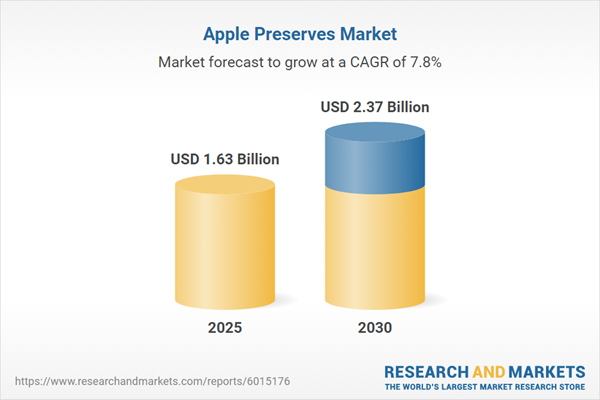Speak directly to the analyst to clarify any post sales queries you may have.
The apple preserves market is evolving rapidly, shaped by shifting consumer trends, modern processing technologies, and strategic responses to regulatory changes. In today’s competitive environment, stakeholders seek actionable intelligence to capitalize on segmentation, innovative distribution, and changing end-user dynamics.
Market Snapshot: Apple Preserves Market Growth and Potential
The Apple Preserves Market grew from USD 1.51 billion in 2024 to USD 1.63 billion in 2025. It is expected to continue growing at a CAGR of 7.98%, reaching USD 2.79 billion by 2032.
This trajectory underscores the market’s resilience, buoyed by the dual appeal of tradition and health-driven demand. Robust expansion is expected across both established and emerging regions, presenting fresh opportunities and new operational challenges for producers and distributors.Scope & Segmentation of the Apple Preserves Market
This market intelligence examines the breadth and depth of the apple preserves landscape. The analysis breaks down distribution models, product innovations, packaging strategies, and user groups to provide a comprehensive view. Key areas include:
- Distribution Channels: Foodservice (cafes, bakeries, catering services, restaurants), online outlets (manufacturer direct, third-party e-commerce), and retail (convenience stores, specialty stores, supermarkets, hypermarkets).
- Product Types: Chunky preserves (rustic profile), organic variants (premium positioning), and smooth styles (versatile applications).
- Packaging Formats: Glass jars (large, medium, small volumes), metal cans (bulk/b2b), plastic jars, and lightweight pouches for portability.
- End Users: Bakeries & confectioneries (artisanal and industrial), food processing companies (confectionery, jam, and spread manufacturers), and households (consumer retail segment).
- Regional Coverage: Americas (including United States, Canada, Mexico, Brazil, Argentina), Europe, Middle East & Africa (UK, Germany, France, UAE, South Africa, Nigeria, and more), and Asia-Pacific (China, India, Japan, Australia, Southeast Asia hub markets).
- Leading Companies: The J. M. Smucker Company, B&G Foods Inc., Andros Group SA, Hero Group SA, Orkla ASA, Del Monte Foods Inc., Welch Foods Inc., Seneca Foods Corporation, Walmart Inc., Materne SA.
Key Takeaways for Senior Decision-Makers
- Product development in apple preserves is being guided by consumer preference for clean-label options, natural ingredients, and transparency in sourcing, driving premiumization across all channels.
- Automation and technology adoption on the production line increase throughput and consistency, while digital marketing enhances consumer engagement, particularly through targeted online channels.
- Differentiation is paramount: organic certification, artisanal provenance, strategic packaging, and unique flavor profiles are crucial levers for sustained brand positioning and customer loyalty.
- Segmented distribution strategies, which target foodservice, e-commerce, and traditional retail, enable companies to optimize logistics and marketing, responding to distinct consumer expectations in each outlet.
- Regional factors, including taste preferences and retail maturity, shape growth strategy—craft food cultures in Western Europe, evolving middle-class demand in Africa, and digitally enabled direct-to-consumer models in Asia-Pacific present tailored opportunities and risks.
Tariff Impact and Strategic Adaptation
The implementation of United States tariffs on apple preserves inputs has introduced supply chain and pricing volatility. Manufacturers are responding by restructuring contracts, diversifying sources, and seeking trade agreement advantages. These adaptive maneuvers aim to secure product availability and manage input costs, all while safeguarding brand consistency for end users.
Methodology & Data Sources
This report integrates primary interviews with industry executives, food technologists, and retail managers, alongside secondary validation using trade publications, disclosure and industry association resources. Data are triangulated for consistency, and statistical analysis is applied to explore underlying cost and sensitivity relationships, delivering accuracy and actionable recommendations.
Why This Report Matters
- Enables senior decision-makers to identify region-specific opportunities and respond swiftly to regulatory changes, such as tariffs.
- Empowers portfolio diversification and product innovation based on robust, multi-layered segmentation and clearly defined end-user profiles.
- Guides resource allocation by illuminating technology, distribution, and packaging trends within the apple preserves industry—and across high-growth segments.
Conclusion
The apple preserves market is shaped by evolving consumer attitudes, regulatory pressures, and technological advancement. Senior executives equipped with the insights in this report can refine market strategy and strengthen competitive positioning in a global, rapidly transforming industry.
Additional Product Information:
- Purchase of this report includes 1 year online access with quarterly updates.
- This report can be updated on request. Please contact our Customer Experience team using the Ask a Question widget on our website.
Table of Contents
3. Executive Summary
4. Market Overview
7. Cumulative Impact of Artificial Intelligence 2025
Companies Mentioned
The companies profiled in this Apple Preserves market report include:- The J. M. Smucker Company
- B&G Foods, Inc.
- Andros Group SA
- Hero Group SA
- Orkla ASA
- Del Monte Foods, Inc.
- Welch Foods Inc.
- Seneca Foods Corporation
- Walmart Inc.
- Materne SA
Table Information
| Report Attribute | Details |
|---|---|
| No. of Pages | 180 |
| Published | October 2025 |
| Forecast Period | 2025 - 2032 |
| Estimated Market Value ( USD | $ 1.63 Billion |
| Forecasted Market Value ( USD | $ 2.79 Billion |
| Compound Annual Growth Rate | 7.9% |
| Regions Covered | Global |
| No. of Companies Mentioned | 11 |









